
“What should I feed my dog?” It’s the most common question that I am asked. I wish I had the ability to magically know what combination of ingredients and protein and fat levels are needed to nurture each one of your unique, individual dogs!
Sorry, but nobody but you can answer that question, because only you can determine how your dog responds to different foods. And that is more important than my opinion or your veterinarian’s opinion or anything else. Your vet, trainer, breeder, or I could give you the names of our very favorite dog-food makers, but there is no guarantee that the products would “perform well” for your dog.
What does it mean to perform well when it comes to dog food? It means it helps promote a healthy stool (not diarrhea or constipation), it maintains or improves your dog’s skin and coat, and it neither makes your dog fat nor thin. As a bonus, your dog should like the taste and be glad to get it!
SUBSCRIBERS ONLY: Click here to see Whole Dog Journal’s list of approved canned dog foods
LEARN THE CHARACTERISTICS OF BETTER CANNED DOG FOOD
What I can do, however, is help you identify things on the label so that you know what to look for and what to look out for, so you can choose the better options from among the products at your disposal, in a price range you can afford, and that work well for your dog.
Note: Calorie for calorie, canned food is very expensive – perhaps the most expensive type of food to feed! While the cheapest foods are most certainly not the best ones for your dog, the price will, to a certain extent, indicate better-quality ingredients and, sometimes, more ethical ones (such as certified wild-caught fish, grass-fed meats, and cage-free poultry).
That said, remember that the most expensive ones are not necessarily “best” for your dog, either! I’ll say it again: You have to feed what works for your individual dog, by trying foods and watching to see his response to them.
1 – Start by looking for a food that is formulated for your Dog’s life stage.
Some foods do not provide all of the nutrients dogs need; they are not “complete and balanced.” If this is so, the label will indicate that they are “for intermittent or supplemental use only.” These products are fine for short-term use or as a “topper” on your dog’s complete and balanced diet, but they will not provide everything your dog needs over time.
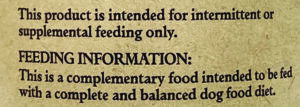
Growing puppies need higher amounts of some nutrients than adult dogs. Complete diets must state whether they have been formulated to meet the nutritional standards for “growth” (puppies) or “adult maintenance.” If the label says the food is for “all life stages,” it has met the “growth” standards. Throwing a wrench in the works, some foods are now using the phrase “growth and maintenance.” This is just another way of saying “all life stages.”

If you are feeding a puppy, you must check to see if the nutritional adequacy statement indicates the food is meant for dogs who are expected to mature to more than 70 pounds or less. (For more information about these statements and feeding puppies, see “Puppy Needs New Food,” WDJ September 2020.)

If you are feeding an adult dog – especially an overweight one – look for a food that is formulated for “adult maintenance.” These foods are almost always lower in fat and protein than food that is formulated for puppies. An exception to this recommendation: dogs who train for or compete in active sports, or who are too thin. In that case, a puppy food (or one for “all life stages”) would be more appropriate.
SUBSCRIBERS ONLY: Click here to see Whole Dog Journal’s list of approved canned dog foods
2 – Next, check the amount of protein and fat. Consider only those products that are appropriate for your dog.
You should have an idea of how much protein and fat you are already feeding your dog. Check the “guaranteed analysis” on the label of the canned food you have at home and compare it to any food you are considering. 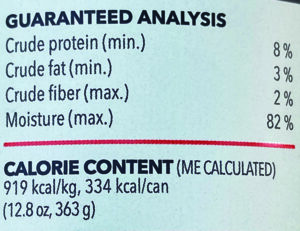
If your dog is overweight, look for a food with less fat in it than the one you are feeding (gram for gram, fat contains more calories than protein or carbs). If he’s too thin, look for a food with more fat than what you’ve been feeding. If he’s just right, try to find a food with the same amount of fat.
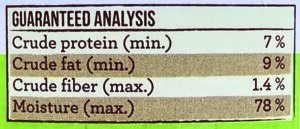
Be aware that these values range widely in pet food; one can of food might contain three times as much protein or fat as another.
If you’re not sure about the fat content, at least check the caloric content on both foods (the one you currently feed and the one under consideration).
3 – Finally, look at the ingredients.
The ingredients are listed in order of their inclusion in the formula by weight. If there are equal amounts of any ingredients, the manufacturer can list those in any order.
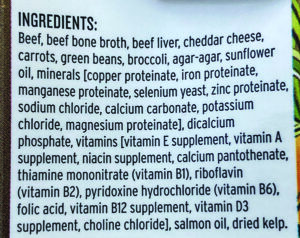
Look for foods that have the animal protein source or sources high atop the list (water or broth may also be first or second, as water is often added as necessary for processing).
Also, look for ingredients that are easy to identify as “food.” (Vitamin and mineral sources are the exception; even the most innocuous vitamins and minerals sound like toxic chemicals; look up any ingredients you’re not sure about!)
Look for whole, named sources of animal protein (i.e., “lamb” rather than “meat”). The amino acid profile of animal protein suits dogs better than proteins from peas, potatoes, corn, soy, etc. If plant proteins are present, we’d like to see them play a minor role, appearing lower on the ingredient list – lower than the fifth or sixth position. When vegetables, fruits, grains, and/or other carbohydrate sources are used, we’d like to see them present whole as opposed to a “fraction” – wheat, for example, as opposed to wheat flour or wheat bran.
Look out for unnamed meats (i.e., “meat,” “poultry”), generic fat sources (e.g., “animal fat”), and artificial colors, flavors, or preservatives (such as BHA, BHT, and/or ethoxyquin). None of these are needed or common in canned food.
Historically, we have rejected foods that are made with animal plasma or blood meal, in favor of more conventional animal protein sources – and we haven’t quite changed our minds about these ingredients yet. There is a case to be made for the nutrient value of blood and blood-sourced products, and an environmental advantage in not wasting those nutrients. We recently met with a representative of a company that collects and processes porcine (pig) and bovine (cow) blood into feed-grade and biomedical products, who answered many of our questions about the safety of these products. We want to learn more, but for now, we’re still rejecting these foods.
If your dog has symptoms of allergy or intolerance – such as chronically inflamed ears or paws, or year-round itching – start trying to identify what ingredient or ingredients may be disagreeing with him. An elimination diet may be in order. Of course, once you have identified which ingredients are problematic for your dog, avoid foods that contain those ingredients in any amount or form. (For example, if he’s allergic to chicken, avoid chicken, chicken meal, chicken by-products, chicken fat, and chicken liver.)
SUBSCRIBERS ONLY: Click here to see Whole Dog Journal’s list of approved canned dog foods
Let’s look at a few canned food ingredient lists. You’ll see that it’s not that hard to identify quality.
Here is Pedigree’s Chopped Ground Dinner with Beef:
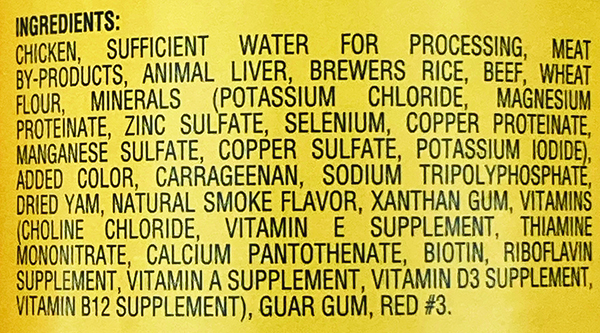
The list starts with chicken – but it’s steeply downhill from there. There is no animal species named in “meat by-products” and “animal liver.” Instead of wheat and rice, it contains wheat flour and brewers rice. Yuck.
Here is a doozy: It’s Cesar Wholesome Bowls Chicken Recipe:

The pet-food companies got the memo about the merits of “real chicken” being first on the ingredients list. But you have to look past that!
Take a look at this one; it’s a little tricky:
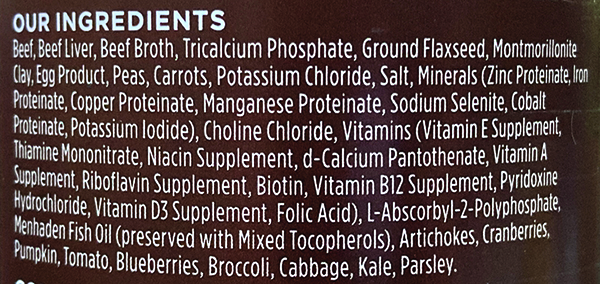
This is Instinct Original Grain-Free Real Beef Recipe. At first glance, it looks like it doesn’t have that many great ingredients; it goes from beef, beef liver, and beef broth to tricalcium phosphate a source of calcium. But this is exactly what to expect in a “98% meat” type of formula (this one is actually 95% beef and liver, according to the label).
However, you also shouldn’t be fooled into thinking that all of the amazing foods after the calcium supplement and the other vitamins and minerals are present in anything like a significant amount. At the end of the ingredients list, there are artichokes, cranberries, pumpkin, tomato, blueberries, and more! If the formula is 95% beef, liver, and water, everything else on that list, added together, is 5% of the total. In other words, those foods are there as a sort of window dressing. They sound great! But there couldn’t be enough of them to make one bit of difference in the formula’s taste, texture, or nutrient content.
SUBSCRIBERS ONLY: Click here to see Whole Dog Journal’s list of approved canned dog foods






One of several foods I use is Nature’s Logic, an excellent product rejected by you for your ridiculous non-acceptance of foods containing blood plasma or meal. I would never feed a canned product containing carrageenan or “natural smoke flavor” but apparently you consider these additives OK. While a whole prey animal (Nature’s perfect dog food) would definitely contain blood/plasma, it certainly wouldn’t contain carrageenan.
When I left my house this morning I found our cat had placed a soft plump mole on the patio to share his pleasure with us. Likely he will have eaten it by the time I have returned. He will consume the whole creature, hide and all including its blood.
However, I will never buy any products that include blood because the Bible strictly forbids the consumption of blood. According to the Genesis account, both people and animals’ diet was in the beginning plants. Genesis 1:29.
When Noah and his family left the ark God expanded their diets to meat, but prohibited eating the animals’ blood. Genesis 9:3,4.
When Moses gave God’s law to the nation of Israel eating blood carried a death penalty. Leviticus 17:10-16
Blood of animals was put on the altar as part of the sacrifices that were offered to God. It was considered holy and could not be used for anything else.
When the Christine congregation was formed the prohibition of the use of blood was retained as part of pure worship. Acts 15:19,20, 29.
Scripturally, blood was viewed as sacred. That is why Jesus shed blood had sacrificial value for us.
Animals can’t read the Bible, nor can they worship God and express faith in Jesus Christ. Humans can, by their respect for God’s prohibition of the use of blood, express their faith in the value of Jesus blood poured out in our behalf. 1 Peter 1:19, 20.
Few people are concerned about God’s laws about anything. Those who do have a reverence for God find no hardship in not feeding blood or its fractions to our pets.
Knowing that God never deprives us of anything we need makes me a label reader to be sure I am not buying blood.
Sure God did not make those rules! It’s humans who made those written rules, some are just so dom and don’t make sense to me. Hoever. If that what makes you happy, great. Please don’t lecture us on what you believe, is god’s word. It’s not, just some lovely written stupidities by men.
This is insightful, as always! But I do think “2 – Next, check the amount of protein and fat” is missing a crucial bit of information. If this is the first article someone has read about canned food, they have likely never considered that the moisture content will change the percentages of the protein and fat!
If people are just comparing the numbers of fat/protein on the label instead of calculating the dry matter percentage, they could end up with the opposite result of what they wanted. A food with 8% fat and 72% moisture has SIGNIFICANTLY less fat than something with 7% fat and 82% moisture. (That’s 29% versus 39%!)